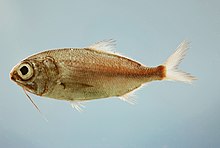Bearded fish
| Bearded fish | ||||||||||||
|---|---|---|---|---|---|---|---|---|---|---|---|---|

Polymixia nobilis , the type species of the genus |
||||||||||||
| Systematics | ||||||||||||
|
||||||||||||
| Scientific name of the order | ||||||||||||
| Polymixiiformes | ||||||||||||
| Rosen & Patterson , 1969 | ||||||||||||
| Scientific name of the family | ||||||||||||
| Polymixiidae | ||||||||||||
| Gill , 1862 | ||||||||||||
| Scientific name of the genus | ||||||||||||
| Polymixia | ||||||||||||
| Lowe , 1838 |
The bearded fish (genus Polymixia ) are a genus of real bony fish (Teleostei) comprising five to nine recent species . The scientific name refers to their skin, which produces "a lot of mucus". The 14 to 48 centimeter long fish live in tropical and subtropical regions of the Atlantic , the Indian Ocean (especially near Natal ) and the western Pacific at depths between 180 and 640 meters.
features
Bearded fish have a moderately elongated, laterally compressed body covered with comb scales . Your eyes are big. Their most striking feature are two head-length hyoid bone barbels , which they use to track down food at the bottom (in sandy to muddy sediment - especially worms, small mussels and crustaceans).
Fin formula : dorsal IV-VI / 26–28, anal IV / 13–17, ventral I / 6, caudal 16.
External system
The systematic position of the bearded fish as a sister group of all other Paracanthopterygii shows the following cladogram:
| Eurypterygii |
|
||||||||||||||||||||||||||||||||||||||||||||||||||||||||||||||||||
|
|
species
After a revision of the genus published in 2019, five of the ten previously described species are still recognized:
- Polymixia berndti Gilbert, 1905 .
- Polymixia japonica Günther , 1877 .
- Polymixia longispina Deng, Xiong & Zhan, 1983 .
- Polymixia lowei Günther, 1859 .
- Polymixia nobilis Lowe, 1838 .
In addition, four clades were found that are likely to have the status of independent species: Polymixia sp. cf. P. japonica, Polymixia sp. cf. P. lowei, Polymixia sp. cf. P. nobilis and Polymixia sp. nov.
In addition to the only genus still alive today, four other fossil genera are known from the Upper Cretaceous : Berycopsis , Dalmatichthys , Omosoma and Omosomopsis . Polymixia is the last survivor of a larger bony fish radation from the Cretaceous period.
literature
- Joseph S. Nelson : Fishes of the World . John Wiley & Sons, 2006, ISBN 0-471-25031-7 .
- Kurt Fiedler: Textbook of Special Zoology, Volume II, Part 2: Fish . Gustav Fischer Verlag Jena, 1991, ISBN 3-334-00339-6 .
Individual evidence
- ^ A b c d W. Calvin Borden, Terry C. Grande, Mark VH Wilson: Phylogenetic relationships within the primitive acanthomorph fish genus Polymixia , with changes to species composition and geographic distributions. PLOSone, March, 2019, doi: 10.1371 / journal.pone.0212954
Web links
- Polymixiiformes on Fishbase.org (English)
- Polymixiidae on Fishbase.org (English)

